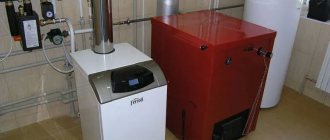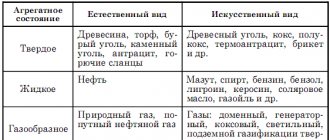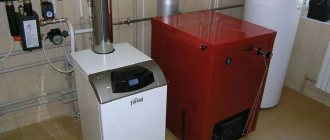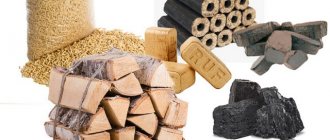14.09.2021 13:52
Heating oil is a petroleum product that is produced from diesel fractions of secondary distillation. It has good fluidity and a low freezing point, and is an inexpensive analogue of diesel fuel.
Due to minor differences from diesel fuel, heating oil is often purchased wholesale and retail for heating boilers. The serviceability and efficiency of expensive heating equipment directly depends on its quality. Therefore, we will consider in detail the characteristics of these petroleum products and find out what fuel can be used for heating boilers.
General characteristics
Boilers that run on diesel fuel are used both in industrial boiler houses and in domestic installations. Domestic boilers can operate on the following energy sources:
- diesel is the highest quality and most expensive fuel. Operating costs when using it are the same as when using gas and electricity, and in some cases even higher;
- stove - similar in characteristics to diesel fuel, but produced from heavier fractions of oil. Its calorific value is 15–20% lower, but the price is almost 2 times lower. Heating oil requires more thorough filtration than diesel.
Heating oil includes various impurities and compounds. It is based on hydrocarbons:
- paraffins;
- mothballs;
- cycloparaffins;
- alkylbenzenes;
- indens;
- acenaphthenes;
- acenaphthylene.
Heating boilers are complex and expensive devices. Therefore, their manufacturers must indicate in the passport the characteristics of the fuel used. The cleaner it is, the more efficiently the equipment operates and the combustion is more efficient.
Table 1. Characteristics of fuel oil (GOST 10585–99)
| Indicators | F-5 | F-12 | 40 | 100 |
| Conditional viscosity at +50 °С, °ВУ | no more than 5.0 | no more than 12.0 | — | — |
| Kinematic viscosity at +50 °C, mm2/s | no more than 36.2 | no more than 89.0 | — | — |
| Conditional viscosity at +80 °С, °ВУ | — | — | no more than 8.0 | no more than 16.0 |
| Kinematic viscosity at +80 °C, mm2/s | — | — | no more than 59.0 | no more than 118.0 |
| Conditional viscosity at +100 °С, °ВУ | — | — | — | no more than 6.8 |
| Kinematic viscosity at +100 °C, mm2/s | — | — | — | no more than 50.0 |
| Dynamic viscosity at 0 °C, Pa s | no more than 2.7 | — | — | — |
| Ash content for low-ash fuel oil, % | — | — | no more than 0.04 | no more than 0.05 |
| Ash content for ash fuel oil, % | no more than 0.05 | no more than 0.10 | no more than 0.12 | no more than 0.14 |
| Mass fraction of mechanical impurities, % | no more than 0.10 | no more than 0.12 | no more than 0.5 | no more than 1.0 |
| Mass fraction of water, % | no more than 0.3 | no more than 0.3 | no more than 1.0 | no more than 1.0 |
| Content of water-soluble acids and alkalis | Absence | |||
| Mass fraction of sulfur for fuel oil I, % | — | — | no more than 0.5 | no more than 0.5 |
| Mass fraction of sulfur for fuel oil II, % | no more than 1.0 | no more than 0.6 | no more than 1.0 | no more than 1.0 |
| Mass fraction of sulfur for fuel oil III, % | — | — | no more than 1.5 | no more than 1.5 |
| Mass fraction of sulfur for fuel oil IV, % | no more than 2.0 | — | no more than 2.0 | no more than 2.0 |
| Mass fraction of sulfur for fuel oil V, % | — | — | no more than 2.5 | no more than 2.5 |
| Mass fraction of sulfur for fuel oil VI, % | — | — | no more than 3.0 | no more than 3.0 |
| Mass fraction of sulfur for fuel oil VII, % | — | — | no more than 3.5 | no more than 3.5 |
| Coking rate, % | no more than 6.0 | no more than 6.0 | — | — |
| Hydrogen sulfide content | Absence | — | — | — |
| Flash point in a closed crucible, °C | not lower than +80 | not lower than +90 | — | — |
| Flash point in an open crucible, °C | — | — | not lower than +90 | not lower than +110 |
| Pour point, °C | no higher than -5 | no higher than -8 | no higher than +10; +25* | no higher than +25; +42* |
| Heat of combustion (lower) in terms of dry fuel (not rejection) for fuel oil types: I, II, III and IV, kJ/kg | no less than 41454 | no less than 41454 | no less than 40740 | no less than 40530 |
| Heat of combustion (lower) in terms of dry fuel (not rejection) for fuel oil types: V, VI and VII, kJ/kg | — | — | not less than 39900 | not less than 39900 |
| Density at +20 °C, kg/m3, no more | 955 | 960 | Not standardized. Definition required | |
* For fuel oil from highly paraffinic oil
Notes:
- In the first and fourth quarters, in fuel oil grades 40 and 100, the flash point in an open crucible is allowed to be no lower than +65 °C, in a closed crucible - not lower than +50 °C, indicating the value of the indicator in agreements and contracts. Such fuel oils are not intended for marine power plants
- Fuel oils grades 40 and 100, made from highly paraffinic oils, are not intended for marine boiler plants
- Indicator 15 for fuel oil grades 40 and 100 is determined for acceptance and delivery operations. When supplying F5, F12, 40 and 100 fuel oils for export, indicator 15 is determined according to [7] and is not a rejection
- Fuel oil grades 40 and 100 produced from gas condensate feedstock must be free of hydrogen sulfide
- Indicator 3 for heating oil of grade 100 is non-rejective until 01/01/2003, and indicator 2 for heating oil of grade 100 is normalized until 01/01/2003
Features of household heating oil
There are no strict standards regulating the manufacturing technology of heating oil, its composition and properties. At the same time, manufacturers are constantly improving it, trying to achieve maximum similarity with a diesel engine.
Heating oil does not have a specific odor that occurs during the combustion of other petroleum products. An important characteristic is the low freezing point, which reaches -28 °C. All these qualities expand the possibilities of using energy.
Heating oil contains more sulfur compounds than diesel fuel. According to their content, PT is divided into 2 types:
- low sulfur - less than 0.5%;
- sulfur - less than 1.1%.
Sulfur is a negative impurity for hydrocarbon products, including heating oil. During the combustion process, it is converted into sulfurous acid, which corrodes the inner surface of boilers and chimneys. Also, its excessive content contributes to the formation of a harmful compound - sulfur dioxide. Consequently, fuel with a lower percentage of sulfur is more suitable for heating equipment.
What is diesel fuel?
Diesel fuel, like heating oil, belongs to the group of petroleum products and consists of the same hydrocarbons. It is obtained by distillation and selection from a certain type of fraction.
Types of diesel fuel Lukoil and Gazprom
Its characteristics are decent:
- Density. This indicator is responsible for the volume of fuel in the generator. With sufficient density, more thermal energy is released.
- Pour point. Not lower than 6 degrees than the ambient temperature.
- Cetane number. An indicator that allows you to highlight data on the ignition delay period of the composition. The larger it is, the more measured and smoothly the diesel fuel burns.
- Viscosity. If the norm is exceeded, fuel atomization will be performed poorly, and this is fraught with early abrasion of parts and frequent breakdowns of mechanisms.
- Sulfur percentage. Sulfur is an important component of diesel fuel. It smells unpleasant due to many toxins, which - alas! - there's no escape. The more sulfur, the more prone the fuel is to detonation, the more tar is released during the cracking process, and the greater the corrosive activity.
- Flammability. Diesel fuel is a non-volatile petroleum product, i.e. the flash point is over 60 degrees.
- Corrosion resistance. A copper plate is used for testing. During the experiment, it is lowered into a container filled with diesel fuel, and after a few hours, experts take it out and evaluate the results.
- The amount of sediment and water in the fuel. The acceptable percentage is very small: no more than 1%.
There are several classifications of diesel fuel:
- Firstly , by the amount of sulfur: the first (up to 350 mg/kg), the second (up to 50 mg/kg) and the third (up to 10 mg/kg) type.
- Secondly , there is summer, winter and arctic diesel fuel. Summer is obtained by distillation. This option is used from April to November (the air temperature should not be below 5 degrees, otherwise the liquid becomes very cloudy and loses quality). Experts advise draining summer diesel fuel in advance - before the onset of the first cold weather. Winter fuel has a lower content of paraffin-forming hydrocarbons and wider viscosity parameters. In central Russia it is used more often and longer. Arctic is popular in regions with permafrost, as well as where air temperatures often drop below 30 degrees. Its viscosity is from 1.45 to 4.6 sq. mm/s, density is 760-820 kg/m3.
REFERENCE! Summer diesel fuel is cheaper than the rest, winter diesel fuel is 20% more expensive than summer diesel fuel, and Arctic diesel fuel is 30-40% more expensive than winter diesel fuel.
Improper use of diesel fuel leads to the formation of paraffin crystals in it, which clog the fuel filter and safety nets, and accumulate in the heat pipe. The fuel pump of the internal combustion engine gradually stops functioning and the engine is damaged.
Differences from diesel fuel
Household heating oil is produced according to specifications, and not according to GOST. This means that each manufacturer has the right to establish independent quality characteristics of the product it produces. These figures are certainly worse than those of diesel. Therefore, when using fuel, it is worth considering the characteristics specified by a specific manufacturer.
| Product Feature | Heating oil | Diesel fuel |
| Raw materials for production | Diesel fractions of secondary origin | Oil |
| Factional composition | 10% is distilled at temperatures above 160 °C; 90% - at 360 °C | 50% - at a temperature of at least 280 °C; 95% - at a temperature of no more than 360 °C |
| Ultimate filterability temperature | -5 °C | -10 °C for summer fuel. Off-season and winter thicken at lower temperatures |
Heating oil is produced through secondary distillation of diesel fractions. The fractional composition of such an energy carrier differs from standard diesel fuel. PT is slightly heavier than diesel and is also characterized by increased viscosity. Since it is produced according to specifications with more strict requirements for the cetane number and the content of sulfur compounds, we can talk about lower quality compared to diesel fuel.
What is the difference in relation to heating boilers?
When using heating oil, it should be taken into account that the requirements of domestic and foreign boiler manufacturers are not the same. For comparison, we will focus on European standards regarding the characteristics of liquid fuel according to EL DIN 51603 standards, which are provided for heating boilers:
- density at 20 °C - 820 - 860 kg/m3;
- viscosity - 6 mm2/s;
- sulfur concentration - 0.005%;
- coking rate - 0.3%;
- ash content - not higher than 0.01%.
To compare heating oil and diesel fuel, it is worth citing the characteristics that are important for use in diesel boilers.
| Product Feature | Heating oil | Diesel fuel |
| Sulfur concentration | 0,5 – 1,1 % | 0,05 % |
| Residue carbonization 10% | up to 0.35% | up to 0.2% |
| Mass fraction of ash | up to 0.2% | up to 0.01% |
Increased viscosity does not greatly affect the functioning of heating equipment. The most significant characteristics are considered to be coking properties and ash content. It is these that the buyer is recommended to pay attention to first. These values indicate the intensity of soot formation on the inner surface of the boiler and chimney. Experiments have demonstrated that a soot layer just 0.01 cm thick reduces boiler efficiency by 4%. When the layer thickness increases by 2 times, the efficiency decreases by 8%.
As for density, cetane and iodine numbers, which are the main characteristics for any fuel, in this case they are not standardized.
Considering all of the above, it can be argued that diesel is better suited for heating boilers than PT. The only advantage of heating oil is the cost; it is 30% cheaper. This difference will allow you to save a large amount, part of which can be spent on maintenance and cleaning of the boiler.
Other indicators
In the production of heating oil, diesel, waste oils and other petroleum products are used. Depending on the initial component, the final raw material receives its own characteristics:
- Density is not standardized by GOST, but is calculated for each type. Determination occurs at +20ºС. In this case, the average value is 930 kg/m³. As the temperature rises, the fuel dilutes, which affects its density.
- Viscosity – demonstrates greater viscosity compared to diesel. Which explains the good thermal performance. The classic parameter is determined at a temperature of +20ºС. The norm is no more than 8 mm²/s.
- Sulfur content - there are two types with high sulfur content and low sulfur content. The mass fractions are 0.5% and 1.1%. A product with a low proportion of sulfur impurities is more popular, since its use increases the service life of equipment. At the same time, it coincides with the requirements of environmental world standards.
- Ash content is a characteristic that determines the remainder of mineral mixtures after complete combustion of raw materials. Exceeding the parameter leads to massive deposits on the internal parts of the equipment, which leads to a decrease in efficiency and breakdowns. For heating oil, this indicator is maintained within 0.02%, which makes it ideal for heating systems.
- Acidity is a parameter that determines the content of acidic compounds. A high percentage causes corrosion of containers and parts, so GOST regulations set a limit of no more than 5 mg KOH/100 cm³.
- Coking resistance - the higher the indicator, the better the internal parts of the equipment are protected from corrosion. For heating oil this parameter does not exceed 0.35%.
- Water content - humidity not only worsens technical performance, but also affects the combustion process and increases the risk of corrosive formations. The parameter is adjusted according to specifications.
If we compare all of the listed qualities with the characteristics of traditional fuel, then this type of energy carrier will win in all respects.
Types of heating oil
There are 2 types of heating oil: light and dark. They differ in viscosity, combustion temperature and impurity content.
In light heating oil the concentration of impurities is lower, it has increased heat transfer, so it is widely used for diesel boilers. Dark is not suitable for use in modern boilers, usually used in equipment with pre-evaporation.
Each type of heating oil has its own advantages:
- light - used for operating large generators. It has increased heat transfer, which makes it possible to avoid expensive diesel when heating large residential premises;
- dark - has a high calorie content, due to this it is characterized by low consumption. Typically used for domestic needs, heating small buildings or utility rooms. Can be used in small power plants.
Methods of obtaining
Heating oil is made from diesel fractions of secondary origin, which are formed during the oil refining process. The technology has low manufacturing costs, since the raw materials are low in price.
About 10% of the fuel is distilled at a temperature of at least 160 °C, 90% at 360 °C. Waste oil may be used during the manufacturing process. It undergoes minimal processing because it already has the necessary properties.
Advantages and disadvantages
Heating oil is used in industrial heating installations and stationary steam boilers. The main purpose is heating of private houses, industrial facilities and agricultural enterprises.
The main reason for using household heating oil instead of diesel is the lower price with similar characteristics. Inexpensive raw materials are used in production, and the finished product has a different taxation. Diesel fuel is expensive because its price includes transport tax.
Additional advantages of PT:
- • good fluidity;
- • economical consumption;
- • high calorific value and efficiency;
- • the ability to reduce the pour point using additives.
- The disadvantages of heating oil include the following:
- • higher amount of sulfur than in diesel;
- • production in accordance with technical specifications, and not GOST (there are no standard values of parameters that manufacturers must adhere to);
- • higher temperature of ultimate filterability.
Experts predict that, due to its characteristics, heating oil will gradually take a leading place in the market and replace traditional types of fuel.
Storage and transportation
There is a large selection of heating oil of different brands on the market, so choosing the right option will not be difficult. Transport fuel raw materials to the place of use in barrels, tanks and other containers. If you need to transport a small volume, even metal or polymer canisters filled to 90–95% will do.
After purchasing the product, it is important to create the correct storage conditions. First of all:
- Remove from sunlight.
- Ensure low humidity in the environment.
- Protect from extremely low temperatures.
Following these simple rules will help preserve its original characteristics and effectively use it as needed.
Is it possible to use heating oil for boilers?
In terms of its characteristics, heating oil is in many ways similar to diesel, but has a number of important differences. PT is produced in accordance with specifications, which are different at each enterprise. This means that less stringent requirements are imposed on the main parameters: cetane and iodine number, cloud point, amount of sulfur, ash mass fraction and viscosity.
Many enterprises strive to approach high standards by producing high-quality petroleum products that best match the properties of diesel fuel. Therefore, heating oil can be used for diesel boilers, taking into account the characteristics of their operation and maintenance.
Bibliography:
- Dotsenko S. P., Tretyakova O. I., Gubanova N. Ya., Korzh I. A., Research and development of composite stove fuel [Electronic resource] - URL: https://cyberleninka.ru/article/n/perspektivy -ispolzovaniya-nefteshlamov-v-sostave-toplivnyh-kompozitsiy/viewer
- Zlobin V. G., Zverev L. O., Increasing the efficiency of liquid fuel boiler plants [Electronic resource] - URL: https://cyberleninka.ru/article/n/povyshenie-effektivnosti-kotelnyh-ustanovok-na-zhidkom- fuel/viewer
- Shrubok A. O., Grushova E. I., Yusevich A. I., Timoshkina M. A., Trukhanovich E. V., Prospects for the use of oil sludge in fuel compositions [Electronic resource] - URL: https://cyberleninka. ru/article/n/metod-parofaznogo-gazohromatograficheskogo-analiza-svetlyh-nefteproduktov/viewer











